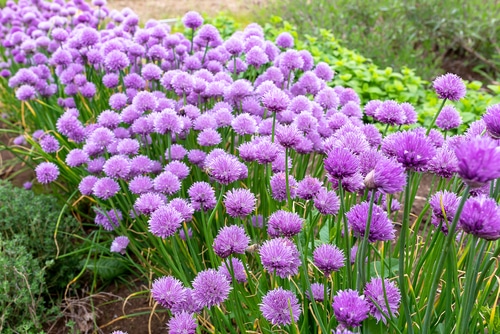Chives are utility plants that serve an important role in the kitchen. The perennial herb is very easy to grow and can quickly spread in the garden.
You’ve probably heard that it’s not good to let herbs flower, but does the same apply to chives? Is it bad if chives flower?
Should I Let Chives Flower?

The good news is that it’s perfectly normal for your chive plants to flower. This phenomenon will not affect the herb’s taste in all its forms.
It’s not a bad thing for chives to produce flowers. In fact, you’d be happy to know that you can pick off the edible blooms and consume them as a delicacy. It’s recommended that you cut off the flower and stalk at its peak to make use of the chive blooms. The hardened stalk becomes non-edible, but the rest of your chives should be fine.
Once your chives begin to flower you can either pinch them off to add to your menu or allow the blooms to go to seed. The seeds collected can become young plants quickly after a few days of sowing. The only downside is that you won’t be able to use the leaves and stems of the chive that has bloomed for soups, summer salads, and omelets, among others.
A flowering chive does not signal the end of its life cycle. You can continue growing the herb and harvesting the leaves as needed. Furthermore, there wouldn’t be a significant change in its flavor and how you can use it on your dishes.
Should You Prune Flowering Chives?
Your chives can benefit from a bit of pruning here and there. A pair of sharp scissors or small garden shears can be put to good use to ensure a plentiful harvest. Aside from promoting new growth, you’ll find that the young and tender chives actually have a stronger flavor than the old leaves.
It’s usually worth the effort to prune your chives. You can keep them looking neat and prevent the herb from spreading to other areas you don’t want. As a potted plant, pruning and regular trimming help keep chives nice and compact.
How you intend to use chives will dictate whether you want to keep the flowers or snip them off as soon as the bud appears. It’s worth noting that the flowers and leaves are edible, as are the bulbs that stay under the soil. If you want to harvest chives for their leaves then you should remove the flowers as soon as they appear. On the other hand, you can let the buds bloom and then take them when they’re fully open.
Alternatively, you can let the flower go to seed and sow them for a new batch of chive plants.
What to Do with Chives When They Have Flowered?
Chives are remarkable herbs because they won’t lose their flavor even after producing blooms. You get a welcome color in the form of pink, purple, red, or white flowers amid the green leaves.
There are two types of chive plants- Chinese chives, or Garlic chives, and the Common chive. Garlic chive plants can grow in zones 4 through 9, while the common variant can grow in zones 3 through 9. Both chive species tend to flower in their growing seasons, from late spring to early summer.
Chives are easy-grow plants that require very little care and maintenance. You can plant them in pots or outside in a small garden bed. The cool season crop should be planted in spring and fall, or indoors about 6-8 weeks before last spring frost in colder regions. Alternatively, you can sow them outdoors once the ground warms up at around 60 to 70 degrees F (or 15 to 21 degrees C).
These herbs can tolerate a bit of drought once established, and you can supplement with a layer of mulch to keep the soil and bulbs moist and cool. You can add nitrogen fertilizer in late spring to keep your chives in a productive state. Remember to keep the soil constantly moist but not waterlogged.
You can begin to harvest leaves after 60 days of seed sowing or a month after for transplants. Use clean scissors to remove leaves at the base, as well as flowers that might appear around late spring or summer.
Related Article: What Herbs Can Be Planted Together?
